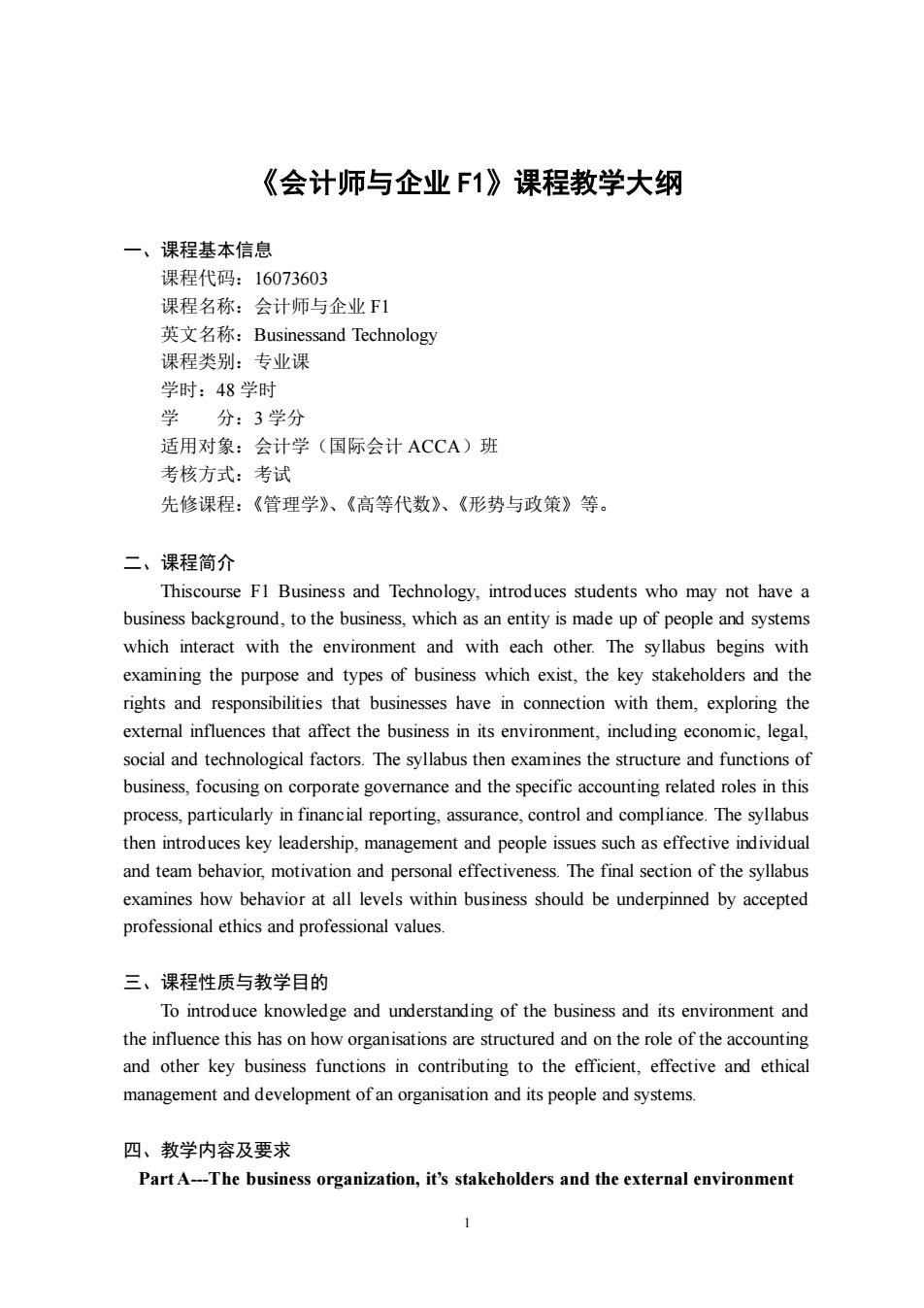
《会计师与企业F1》课程教学大纲 一、课程基本信息 课程代码:16073603 课程名称:会计师与企业F1 英文名称:Businessand Technology 课程类别:专业课 学时:48学时 学 分:3学分 适用对象:会计学(国际会计ACCA)班 考核方式:考试 先修课程:《管理学》、《高等代数》、《形势与政策》等。 二、课程简介 Thiscourse FI Business and Technology,introduces students who may not have a business background,to the business,which as an entity is made up of people and systems which interact with the environment and with each other.The syllabus begins with examining the purpose and types of business which exist,the key stakeholders and the rights and responsibilities that businesses have in connection with them,exploring the external influences that affect the business in its environment,including economic,legal, social and technological factors.The syllabus then examines the structure and functions of business,focusing on corporate governance and the specific accounting related roles in this process,particularly in financial reporting.assurance.control and compliance.The syllabus then introduces key leadership,management and people issues such as effective individual and team behavior,motivation and personal effectiveness.The final section of the syllabus examines how behavior at all levels within business should be underpinned by accepted professional ethics and professional values. 三、课程性质与教学目的 To introduce knowledge and understanding of the business and its environment and the influence this has on how organisations are structured and on the role of the accounting and other key business functions in contributing to the efficient,effective and ethical management and development of an organisation and its people and systems 四、教学内容及要求 Part A-The business organization,it's stakeholders and the external environment 1
1 《会计师与企业 F1》课程教学大纲 一、课程基本信息 课程代码:16073603 课程名称:会计师与企业 F1 英文名称:Businessand Technology 课程类别:专业课 学时:48 学时 学 分:3 学分 适用对象:会计学(国际会计 ACCA)班 考核方式:考试 先修课程:《管理学》、《高等代数》、《形势与政策》等。 二、课程简介 Thiscourse F1 Business and Technology, introduces students who may not have a business background, to the business, which as an entity is made up of people and systems which interact with the environment and with each other. The syllabus begins with examining the purpose and types of business which exist, the key stakeholders and the rights and responsibilities that businesses have in connection with them, exploring the external influences that affect the business in its environment, including economic, legal, social and technological factors. The syllabus then examines the structure and functions of business, focusing on corporate governance and the specific accounting related roles in this process, particularly in financial reporting, assurance, control and compliance. The syllabus then introduces key leadership, management and people issues such as effective individual and team behavior, motivation and personal effectiveness. The final section of the syllabus examines how behavior at all levels within business should be underpinned by accepted professional ethics and professional values. 三、课程性质与教学目的 To introduce knowledge and understanding of the business and its environment and the influence this has on how organisations are structured and on the role of the accounting and other key business functions in contributing to the efficient, effective and ethical management and development of an organisation and its people and systems. 四、教学内容及要求 Part A---The business organization, it’s stakeholders and the external environment
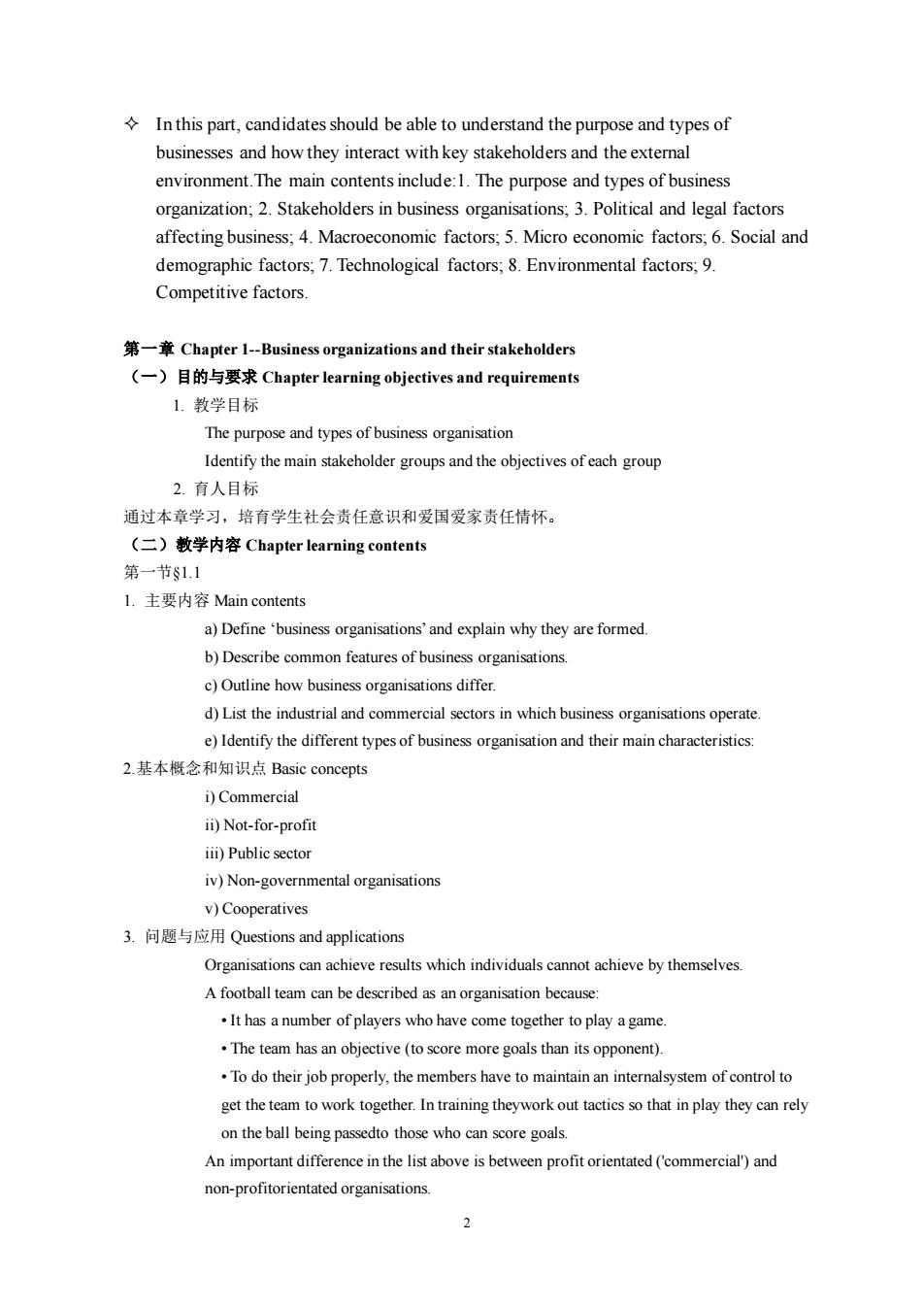
In this part,candidates should be able to understand the purpose and types of businesses and how they interact withkey stakeholders and the extemal environment The main contents include:1.The purpose and types of business organization;2.Stakeholders in business organisations,3.Political and legal factors affecting business,4.Macroeconomic factors,5.Micro economic factors,6.Social and demographic factors;7.Technological factors,8.Environmental factors,9. Competitive factors 第一章Chapter 1-Business organizations and their stakeholder (一)目的与要求Chapter learning objectives and requirements 1.教学目标 The purpose and types of business organisation Identify the main stakehoder groupsand the objectives 2.有人目标 通过本章学习,培有学生社会责任意识和爱国爱家责任情怀 (二)教学内容Chapter learning contents 第一节1.1 L.主要内容Main contents a)Definebusiness organisations'and explain why they are formed b)Describe common features of business organisations. )Outline how business organisations differ d)List the industrial and commercial sectors in which business organisations operate e)Identify the different typesof business organisation and their maincharacteristics 2.基本概念和知识点Basic concepts i)Commercial ii)Not-for-profit iii)Public sector iv)Non-governmental organisations v)Cooperatives 3.问题与应用Questions and applications Organisations can achieve results which individuals cannot achieve by themselves. A football team can be described as an organisation becaus It has a number of players who have come together to play a game .The team has an objective(to score more goals than its opponent) .To do their job properly,the members have to maintain an internalsystem of control to get the te to work together.theyworkou tactics so that in play they can rely on the ball being passedto those who can score goals An important difference in the list above is between profit orientated(commercialand non-profitorientated organisations. 2
2 In this part, candidates should be able to understand the purpose and types of businesses and how they interact with key stakeholders and the external environment.The main contents include:1. The purpose and types of business organization; 2. Stakeholders in business organisations; 3. Political and legal factors affecting business; 4. Macroeconomic factors; 5. Micro economic factors; 6. Social and demographic factors; 7. Technological factors; 8. Environmental factors; 9. Competitive factors. 第一章 Chapter 1--Business organizations and their stakeholders (一)目的与要求 Chapter learning objectives and requirements 1. 教学目标 The purpose and types of business organisation Identify the main stakeholder groups and the objectives of each group 2. 育人目标 通过本章学习,培育学生社会责任意识和爱国爱家责任情怀。 (二)教学内容 Chapter learning contents 第一节§1.1 1. 主要内容 Main contents a) Define ‘business organisations’ and explain why they are formed. b) Describe common features of business organisations. c) Outline how business organisations differ. d) List the industrial and commercial sectors in which business organisations operate. e) Identify the different types of business organisation and their main characteristics: 2.基本概念和知识点 Basic concepts i) Commercial ii) Not-for-profit iii) Public sector iv) Non-governmental organisations v) Cooperatives 3. 问题与应用 Questions and applications Organisations can achieve results which individuals cannot achieve by themselves. A football team can be described as an organisation because: • It has a number of players who have come together to play a game. • The team has an objective (to score more goals than its opponent). • To do their job properly, the members have to maintain an internalsystem of control to get the team to work together. In training theywork out tactics so that in play they can rely on the ball being passedto those who can score goals. An important difference in the list above is between profit orientated ('commercial') and non-profitorientated organisations

The that make up the vary country,but generally include: ·police military public transport ·primary education healthcare for the poor The private secor will therefore normaly include Within these will be both profitseeking and notforprofitorganisations businesses charities and ·clubs. A non-governmental organisation(NGO)is a legally constituted organisation of people acting togetherindependently from any form of government. NGOs include .the Red Cross .Doctors Without Borders ·Greenpeace .Amnesty International In the UK,the largest example of a co-operative is the Co-operative Group,which has over 5.5million members and operates in diverse markets.such as banking.travel and groceries 第二节§1.2 L.主要内容Main contents a)Define stakeholders and explain the agency relationship in business and how it may vary in different types of business organisaion. b)Define internal,connected and external stakeholders and explain their impact on the organisation. c)Identify the main stakeholder groups and the objectives of each group. )Explain how the different how their objectives may conflict with one another. e)Compare the power and ofvarious stakeholder groupsand how theirneeds should be accounted for,such as under the Mendelow framework. 2.基本概念和知识点Basic concepts internal,connected and external stakeholders Stakeholders are those individuals or groups that,potentially,have an interest in what the organizationdoes These stakeholders can be within to the 3
3 The organisations that make up the public sector vary from country to country, but generally include: • police • military • public transport • primary education • healthcare for the poor The private sector will therefore normally include: Within these will be both profitseeking and notforprofitorganisations. • businesses • charities and • clubs. A non-governmental organisation (NGO) is a legally constituted organisation of people acting togetherindependently from any form of government. NGOs include: • the Red Cross • Doctors Without Borders • Greenpeace • Amnesty International In the UK, the largest example of a co-operative is the Co-operative. Group, which has over 5.5 million members and operates in diverse markets, such as banking, travel and groceries 第二节§1.2 1. 主要内容 Main contents a) Define stakeholders and explain the agency relationship in business and how it may vary in different types of business organisation. b) Define internal, connected and external stakeholders and explain their impact on the organisation. c) Identify the main stakeholder groups and the objectives of each group. d) Explain how the different stakeholder groups interact and how their objectives may conflict with one another. e) Compare the power and influence of various stakeholder groups and how their needs should be accounted for, such as under the Mendelow framework. 2. 基本概念和知识点 Basic concepts internal, connected and external stakeholders 3. 问题与应用 Questions and applications Stakeholders are those individuals or groups that, potentially, have an interest in what the organizationdoes. These stakeholders can be within the organisation, connected to the
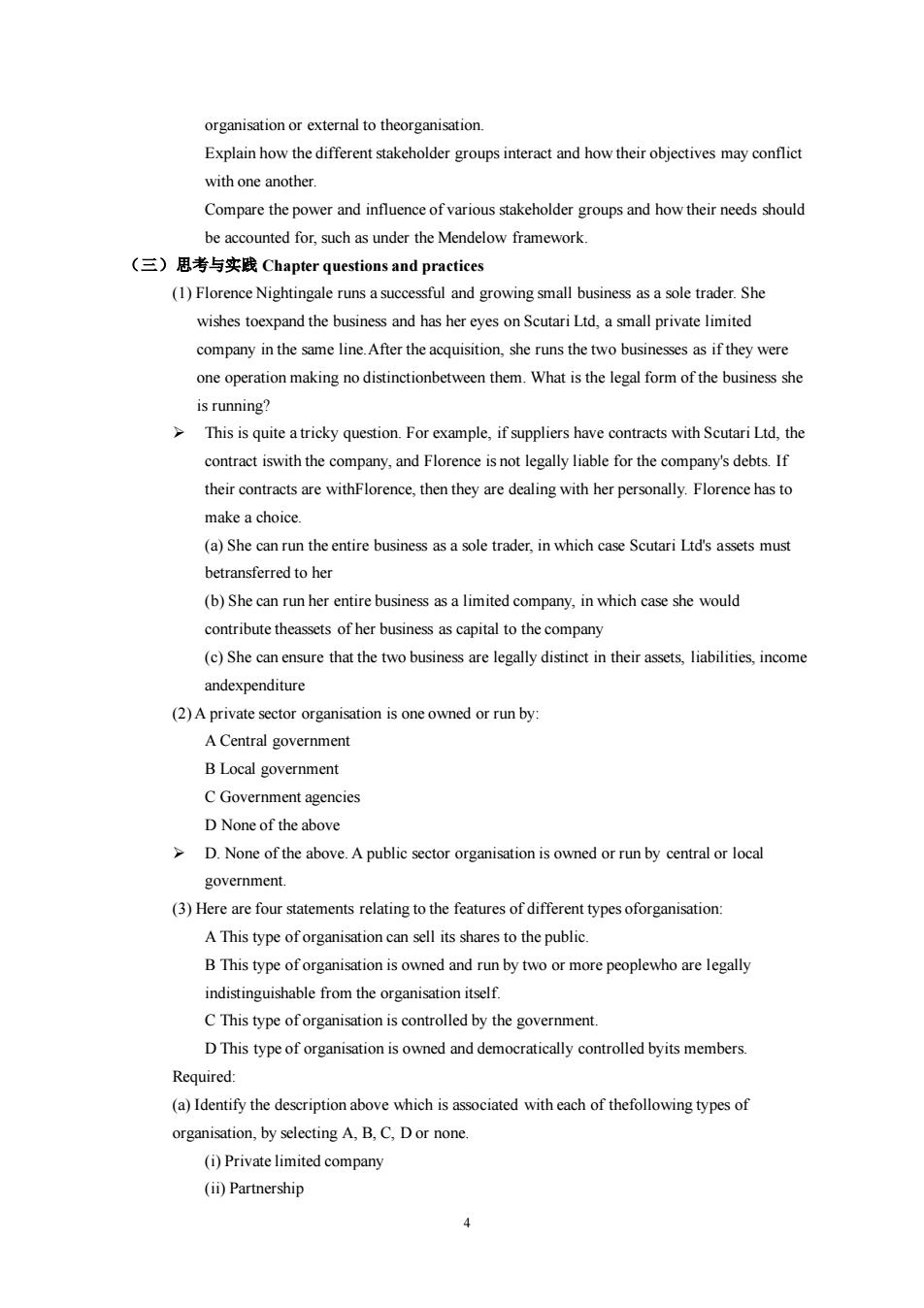
organisation or external to theorganisation. Explain how the different stakeholder groups interact and how theirobjectives may confic with one another Compare the power and influence of various stakeholder groups and how their needs should be accounted for,such as under the Mendelow framework. (三)思考与实践Chapter questions and practices (1)Florence Nightingale runs asuccessful and growing small business asasole trader.She wishes toexpand the business and has her eyes on Scutari Ltd,a small private limited company in the same lineAfter the acquisition,she runs the two businesses as if they were one operation making no distinctionbetween them.What is the legal form of the business she isrunning? >This is quite a tricky question.For example.if suppliers have contracts with Scutari Ltd.the contract iswith the company,and Forence isnot legally liable for the company's debts.If their contracts are withFlorence,then they are dealing with her personally.Florence has to make a choice. (a)She can run theentire business as a sole trader,in which case Scutari Ld's assets must betransferred to her (b)She can run her entire business as a limited company,in which case she would contribute theassets of her business as capital to the company (e)She can ensure that the two business are legally distinct in their assets,liabilities,income andexpenditure (2)A private sector organisation is one owned or run by: A Central government B Local government C Government agencies D None of the above >D.None of the above.A public sector organisation is owned or run by central or local government. (3)Here are four statements relating to the features of different types oforganisation: AThis type of organisation can sell its shares to the public. B This type of organisation is owned and run by two or more peoplewho are legally indistinguishable from tsef C This type of organisation is controlled by the government. DThis type of organisation is owned and democratically conrolled byits members Required: (a)Identify the description bove which is with each of thefollowing types of organisation,by selecting A.B.C.Dor none. (i)Private limited company (ii)Partnership
4 organisation or external to theorganisation. Explain how the different stakeholder groups interact and how their objectives may conflict with one another. Compare the power and influence of various stakeholder groups and how their needs should be accounted for, such as under the Mendelow framework. (三)思考与实践 Chapter questions and practices (1) Florence Nightingale runs a successful and growing small business as a sole trader. She wishes toexpand the business and has her eyes on Scutari Ltd, a small private limited company in the same line.After the acquisition, she runs the two businesses as if they were one operation making no distinctionbetween them. What is the legal form of the business she is running? ➢ This is quite a tricky question. For example, if suppliers have contracts with Scutari Ltd, the contract iswith the company, and Florence is not legally liable for the company's debts. If their contracts are withFlorence, then they are dealing with her personally. Florence has to make a choice. (a) She can run the entire business as a sole trader, in which case Scutari Ltd's assets must betransferred to her (b) She can run her entire business as a limited company, in which case she would contribute theassets of her business as capital to the company (c) She can ensure that the two business are legally distinct in their assets, liabilities, income andexpenditure (2) A private sector organisation is one owned or run by: A Central government B Local government C Government agencies D None of the above ➢ D. None of the above. A public sector organisation is owned or run by central or local government. (3) Here are four statements relating to the features of different types oforganisation: A This type of organisation can sell its shares to the public. B This type of organisation is owned and run by two or more peoplewho are legally indistinguishable from the organisation itself. C This type of organisation is controlled by the government. D This type of organisation is owned and democratically controlled byits members. Required: (a) Identify the description above which is associated with each of thefollowing types of organisation, by selecting A, B, C, D or none. (i) Private limited company (ii) Partnership
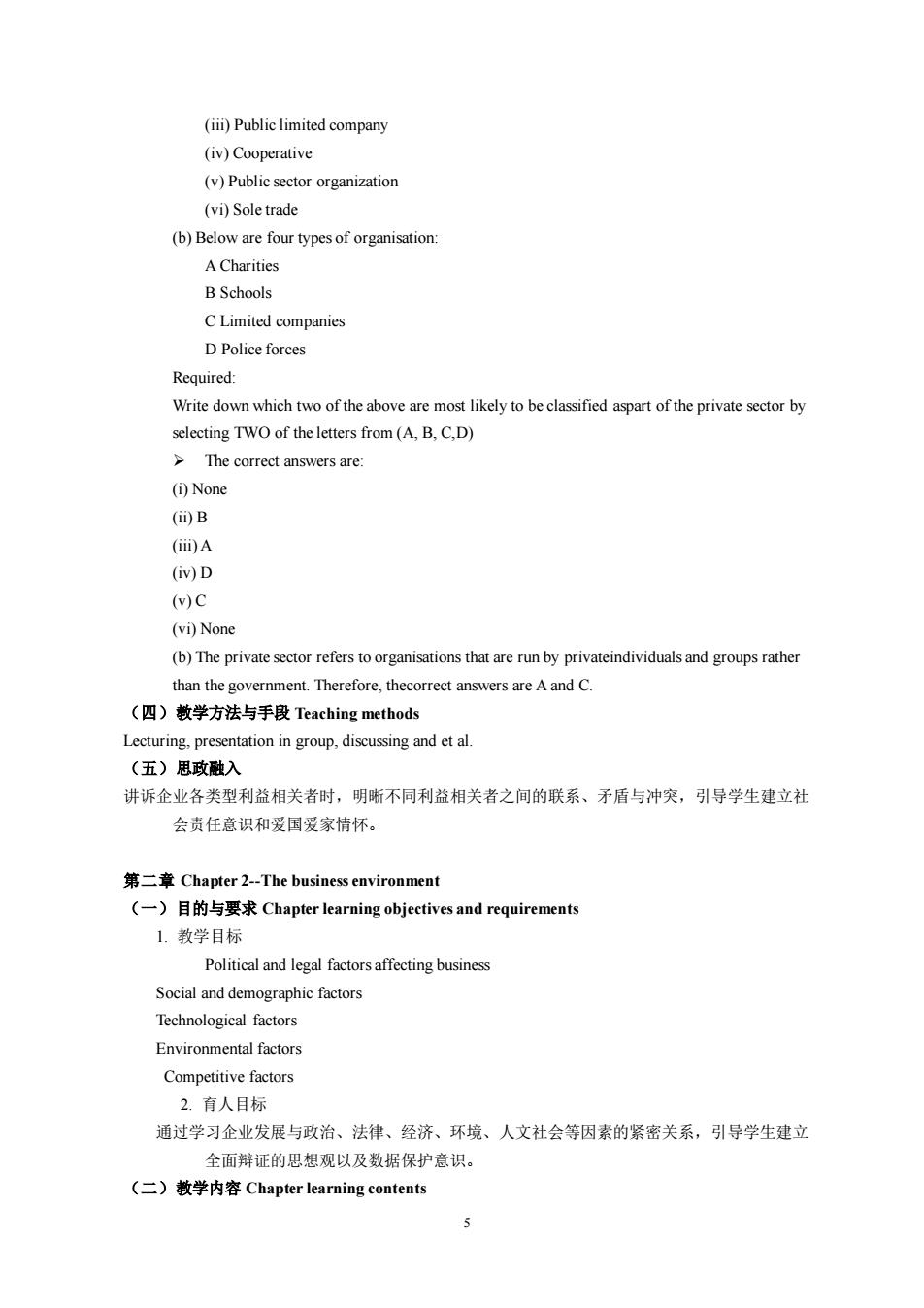
(i)Public limited company (iv)Cooperative (v)Public sector organization (vi)Sole trade (b)Below are four typesof organisation A Charities CLimited companies D Police forces Required: Write down which two of the above are most likely to be classified aspart of the private sector by selecting TWO of the letters from(A.B.C.D) The correct answers are: (i)None (ii)B (iiD)A (iv)D (v)C (vi)None (b)The private sector refers to organisations that are run by privateindividuals and groups rather than the government.Therefore,thecorrect answers are Aand C. (四)教学方法与手段Teaching methods Lecturing.presentation in group,discussing and et al (五)思政融入 讲诉企业各类型利益相关者时,明晰不同利益相关者之间的联系、矛后与冲突,引导学生建立社 会责任意识和爱国爱家情怀。 第二章Chapter2-The business environment (一)目的与要求Chapter learning objectives and requirements 1.教学目标 Political and legal factors affecting business Social and demographic factors Technological factors Environmental factors Competitive factors 2.育人目标 通过学习企业发展与政治、法律、经济、环境、人文社会等因素的紧密关系,引导学生建立 全面辩证的思想观以及数据保护意识。 (二)教学内容Chapter learning contents 5
5 (iii) Public limited company (iv) Cooperative (v) Public sector organization (vi) Sole trade (b) Below are four types of organisation: A Charities B Schools C Limited companies D Police forces Required: Write down which two of the above are most likely to be classified aspart of the private sector by selecting TWO of the letters from (A, B, C,D) ➢ The correct answers are: (i) None (ii) B (iii) A (iv) D (v) C (vi) None (b) The private sector refers to organisations that are run by privateindividuals and groups rather than the government. Therefore, thecorrect answers are A and C. (四)教学方法与手段 Teaching methods Lecturing, presentation in group, discussing and et al. (五)思政融入 讲诉企业各类型利益相关者时,明晰不同利益相关者之间的联系、矛盾与冲突,引导学生建立社 会责任意识和爱国爱家情怀。 第二章 Chapter 2--The business environment (一)目的与要求 Chapter learning objectives and requirements 1. 教学目标 Political and legal factors affecting business Social and demographic factors Technological factors Environmental factors Competitive factors 2. 育人目标 通过学习企业发展与政治、法律、经济、环境、人文社会等因素的紧密关系,引导学生建立 全面辩证的思想观以及数据保护意识。 (二)教学内容 Chapter learning contents
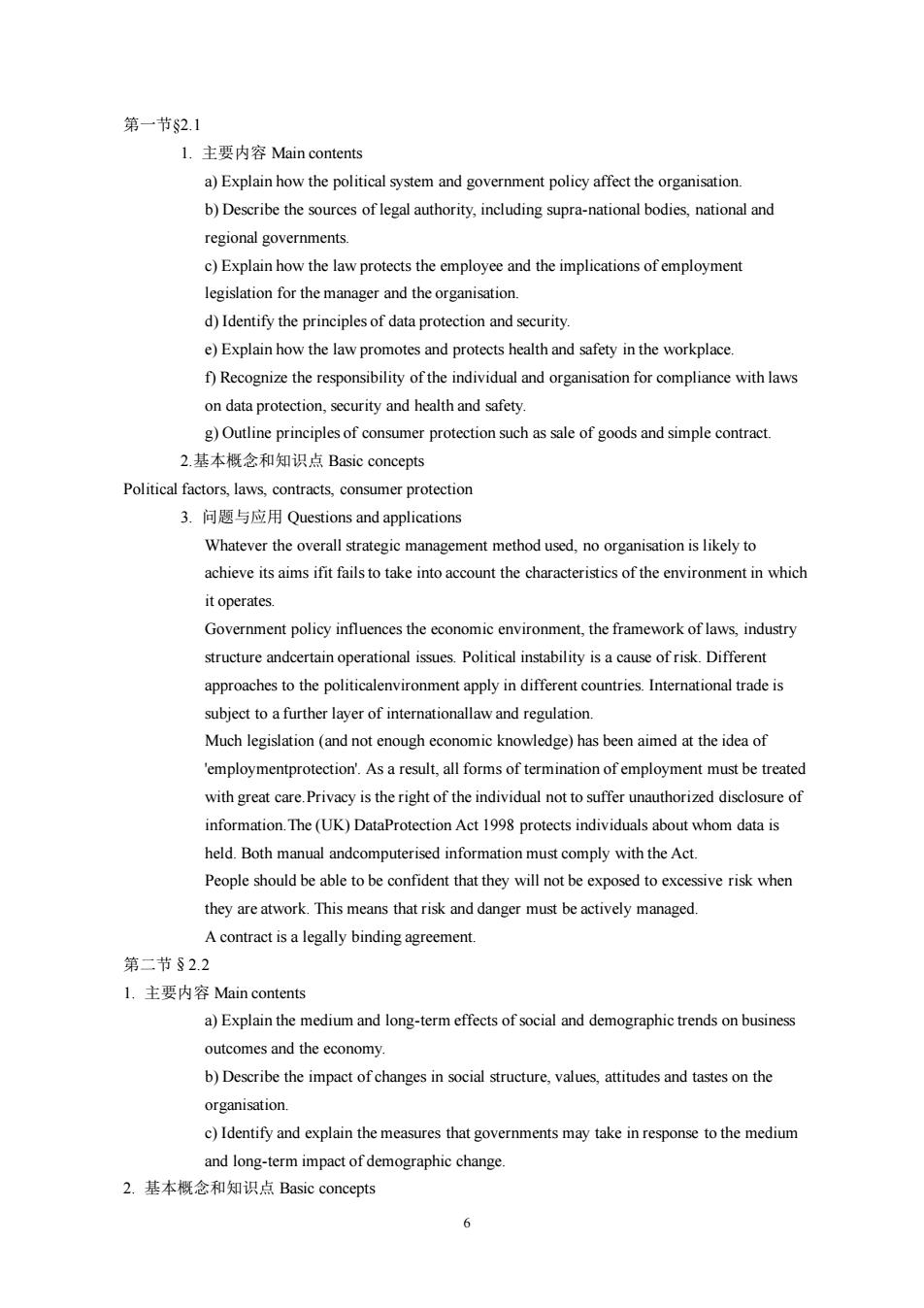
第一节2.1 L.主要内容Main contents a)Explain how the political system and government policy affect the organisation. b)Describe the sources of legal authority,including supra-national bodies,national and regional governments. c)Explain how the law protects the employee and the implications of employment for the manager and the organisation. d)Identify the principles of data protection and security. e)Explain how the law promotes and protects health and safety in the workplace. f)Recognize the responsibility of the individual and organisation for compliance with laws on data protection,security and health and safety g)Outline principles of consumer protection such as sale of goods and simple contract. 2.基本概念和知识点Basic concepts Political factors,laws,contracts,consumer protection 3.问题与应用applications Whatever the overall strategic management method used,no organisation is likely to achieve fails to take the characterisi of whic it operates. Government policy influences,the framework of laws,industry structure andcertain operational issues Political instability is a cause of risk.Different approaches to the apply in different Interational trade is subiect to a further laver of internationallaw and regulation. Much legislation (and not enough knowledge)has been aimed at the idea of 'employmentprotection.As a result,all forms of termination of employment must be treated with great care.Privacy is the right of the individual not to suffer unauthorized disclosureo information.The(UK)DataProtection Act 19 protects individuals about whom data is held.Both manual andcomputerised information must comply with the Act. People should be able to be confident that they will not be exposed to excessive risk when they are atwork.This means that risk and danger must be actively managed. A contract is a legally binding agreement 第二节82.2 .主要内容Main contents a)Explain the medium and long-term effects of social and demographic trends on business outcomes and the economy b)Describe the impact of changes in social structure.values.attitudes and tastes on the organisation c)Identify and explain the measures that governments may take in response to the medium and long-term impact of demographic change. 2.基本概念和知识点Basic concepts 6
6 第一节§2.1 1. 主要内容 Main contents a) Explain how the political system and government policy affect the organisation. b) Describe the sources of legal authority, including supra-national bodies, national and regional governments. c) Explain how the law protects the employee and the implications of employment legislation for the manager and the organisation. d) Identify the principles of data protection and security. e) Explain how the law promotes and protects health and safety in the workplace. f) Recognize the responsibility of the individual and organisation for compliance with laws on data protection, security and health and safety. g) Outline principles of consumer protection such as sale of goods and simple contract. 2.基本概念和知识点 Basic concepts Political factors, laws, contracts, consumer protection 3. 问题与应用 Questions and applications Whatever the overall strategic management method used, no organisation is likely to achieve its aims ifit fails to take into account the characteristics of the environment in which it operates. Government policy influences the economic environment, the framework of laws, industry structure andcertain operational issues. Political instability is a cause of risk. Different approaches to the politicalenvironment apply in different countries. International trade is subject to a further layer of internationallaw and regulation. Much legislation (and not enough economic knowledge) has been aimed at the idea of 'employmentprotection'. As a result, all forms of termination of employment must be treated with great care.Privacy is the right of the individual not to suffer unauthorized disclosure of information.The (UK) DataProtection Act 1998 protects individuals about whom data is held. Both manual andcomputerised information must comply with the Act. People should be able to be confident that they will not be exposed to excessive risk when they are atwork. This means that risk and danger must be actively managed. A contract is a legally binding agreement. 第二节§2.2 1. 主要内容 Main contents a) Explain the medium and long-term effects of social and demographic trends on business outcomes and the economy. b) Describe the impact of changes in social structure, values, attitudes and tastes on the organisation. c) Identify and explain the measures that governments may take in response to the medium and long-term impact of demographic change. 2. 基本概念和知识点 Basic concepts
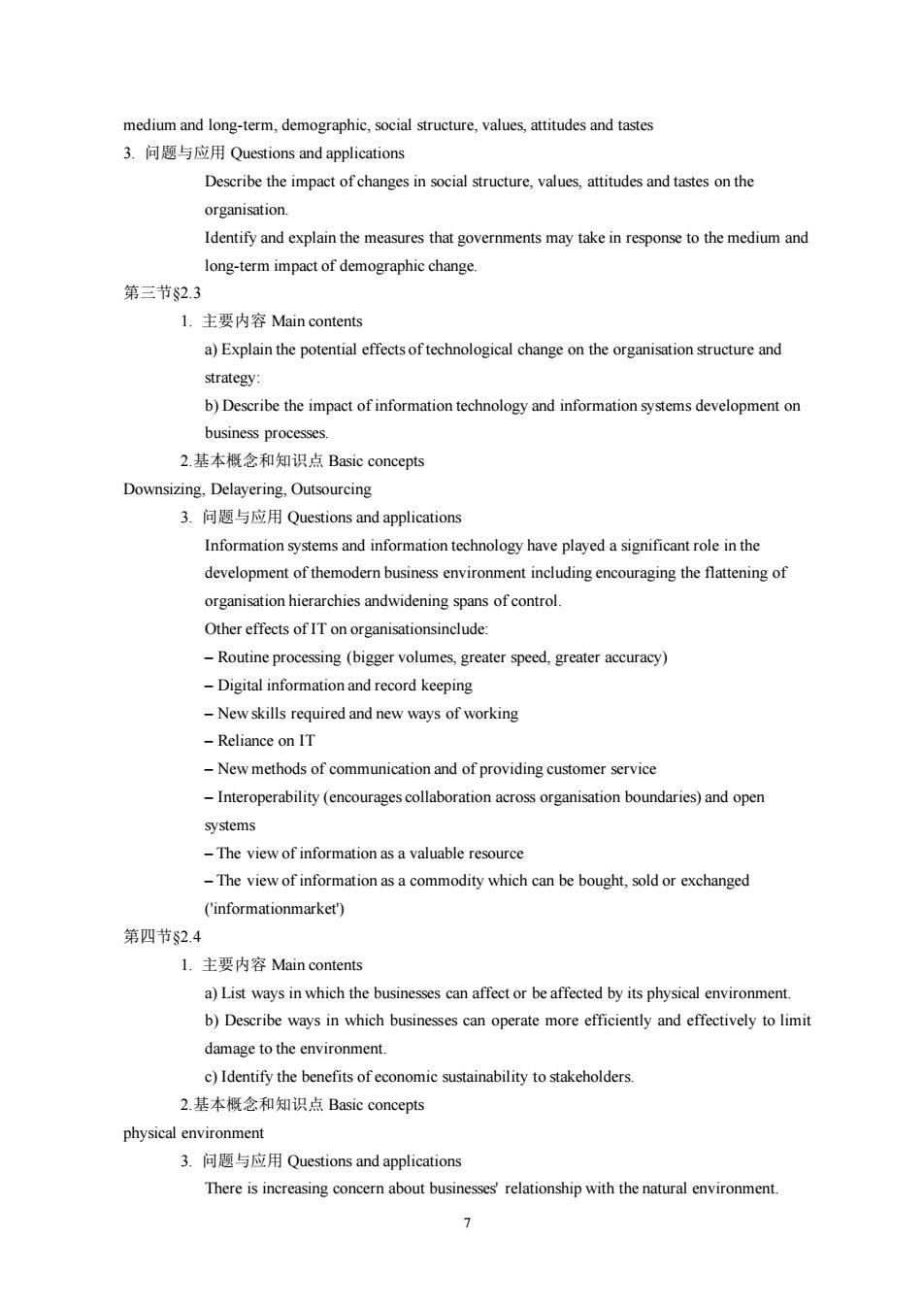
medium and long-term,demographic,sc structure,values,attitudes and tastes 3.问愿与应用Questions and applications Describe the impact of changes in social structure,values,attitudes and tastes on the organisation. Identify and explain the measures that governments may take in response to the medium and long-term impact of demographic change. 第三节S23 L.主要内容Main contents a)Explain the potential effects of technological change on the and strategy: b)Describe the impact of information technology and information systems development on business processes. 2,基本概念和知识点Basic concepts Downsizing,Delayering.Outsourcing 3.问题与应用Questions and applications Information systems and information technology have played a significant role in the development of themoden business environment organisation hierarchies andwidening spans of control. Other effects ofITonorganisationsinclud -Routine processing (bigger volumes,greater speed,greater accuracy) -Digital information and record keeping -New skills required and new ways of working Reliance on IT -New methods of communication and of providing customer service Interoperability (encourages collaboration across organisation boundaries)and open systems -The view of information as a valuable resource -The view of information as a commodity which can be bought,sold or exchanged ('informationmarket') 第四节2.4 1.主要内容Main contents a)List ways in which the businesses can affect or be affected by its physical environmen b)Describe ways in which businesses can operate more efficiently and effectively to limit damage to the environment c)Identify the benefits of economic sustainability to stakeholders. 2.基本概念和知识点Basic concepts physical environment 3.问题与应用Questions and applications There is increasing concern about businesses'relationship with the natural environment. 7
7 medium and long-term, demographic, social structure, values, attitudes and tastes 3. 问题与应用 Questions and applications Describe the impact of changes in social structure, values, attitudes and tastes on the organisation. Identify and explain the measures that governments may take in response to the medium and long-term impact of demographic change. 第三节§2.3 1. 主要内容 Main contents a) Explain the potential effects of technological change on the organisation structure and strategy: b) Describe the impact of information technology and information systems development on business processes. 2.基本概念和知识点 Basic concepts Downsizing, Delayering, Outsourcing 3. 问题与应用 Questions and applications Information systems and information technology have played a significant role in the development of themodern business environment including encouraging the flattening of organisation hierarchies andwidening spans of control. Other effects of IT on organisationsinclude: – Routine processing (bigger volumes, greater speed, greater accuracy) – Digital information and record keeping – New skills required and new ways of working – Reliance on IT – New methods of communication and of providing customer service – Interoperability (encourages collaboration across organisation boundaries) and open systems – The view of information as a valuable resource – The view of information as a commodity which can be bought, sold or exchanged ('informationmarket') 第四节§2.4 1. 主要内容 Main contents a) List ways in which the businesses can affect or be affected by its physical environment. b) Describe ways in which businesses can operate more efficiently and effectively to limit damage to the environment. c) Identify the benefits of economic sustainability to stakeholders. 2.基本概念和知识点 Basic concepts physical environment 3. 问题与应用 Questions and applications There is increasing concern about businesses' relationship with the natural environment

Businesses maysuffer significant costs and a loss of reputation if problems arise. 第五节52.5 1.主要内容Main contents a)Identify a business's strengths,weaknesses opportunities and threats(SWOT)in amarket and the main soures of competitive advantage. b)Identify the main elements within Porter's value chain and explain the meaning of a value network c)Explain the factors or forces that influence the level of competitiveness in an industry or sector using Porter's five forces model. d)Describe the activities of an organisation that affect its competitiveness 2.基本概念和知识点Basic concepts SWOT.value chai.competitive forces 3.问题与应用applications The value chain describes those activities of the organisation that add value to purchased inputsPrimary activitiesare involved in the production of goods and services.Support activities providenecessary assistance.Linkages are the relationships between activities Managing the value chain,which inudes relationships with outside bea source of strategic advantage.The competitive environment is structured by five forces. barriers to enry.substitute products thebargaining power of customers.the bargaining power of suppliers:competitive rivalry i)Purchasing ii)Production im)Marketing iv)Service (三)思考与实践Chapter questions and practices (1) For example,a haulage firm might monitor the following factors. Political .Fuel tax .Government steps to reduce pollution from ories .Congestion charges in cities .Plans to build new roads .Road blockades due to strikes(e.g.in France) .State of the economy-a downturn would result in less trade Fuel is amajor cost movements will be seen as significant Most hauliers borrow to purchase trucks,rate would increase costs 8
8 Businesses maysuffer significant costs and a loss of reputation if problems arise. 第五节§2.5 1. 主要内容 Main contents a) Identify a business’s strengths, weaknesses opportunities and threats (SWOT) in a market and the main sources of competitive advantage. b) Identify the main elements within Porter’s value chain and explain the meaning of a value network c) Explain the factors or forces that influence the level of competitiveness in an industry or sector using Porter’s five forces model. d) Describe the activities of an organisation that affect its competitiveness: 2. 基本概念和知识点 Basic concepts SWOT, value chai, competitive forces 3. 问题与应用 Questions and applications The value chain describes those activities of the organisation that add value to purchased inputs.Primary activities are involved in the production of goods and services. Support activities providenecessary assistance. Linkages are the relationships between activities. Managing the value chain,which includes relationships with outside suppliers, can be a source of strategic advantage.The competitive environment is structured by five forces: barriers to entry; substitute products; thebargaining power of customers; the bargaining power of suppliers; competitive rivalry. i) Purchasing ii) Production iii) Marketing iv) Service (三)思考与实践 Chapter questions and practices (1) For example, a haulage firm might monitor the following factors: Political •Fuel tax • Government steps to reduce pollution from lorries • Congestion charges in cities • Plans to build new roads • Road blockades due to strikes (e.g. in France) Economic • State of the economy – a downturn would result in less trade • Fuel is a major cost so oil price movements will be seen as significant • Most hauliers borrow to purchase trucks, so a rise in interest rate would increase costs
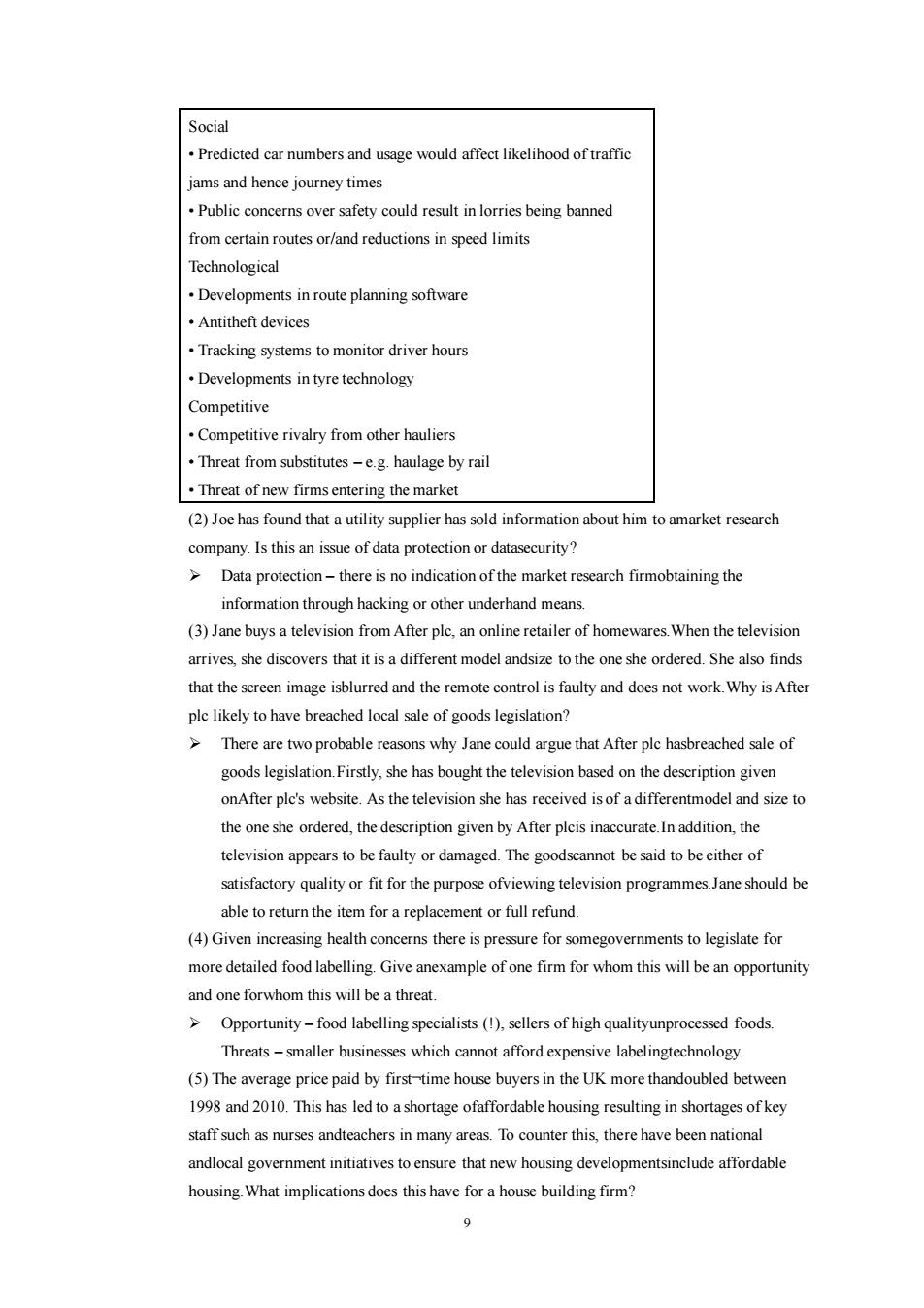
Social Predicted car numbers and usage would affect likelihood of traffic jams and hence journey times .Public concerns over safety could result in lorries being banned from certain routes or/and reductions in speed limits Technological Developments in route planning software ·Antitheft devices .Tracking systems to monitor driver hours Developments in tyre technology Competitive .Competitive rivalry from other hauliers .Threat from substitutes-eg.haulage by rail .Threat of new firms entering the market (2)Joe has found that a utility supplier has sold information about him to amarket research ompany.Is thisan issue of data? >Data protection-there is no indication of the market research firmobtaining the nformation through hackingorother underhand means. (3)Jane buys a television from After plc,an online retailer of homewares.When the television that the screen image isblurred and the remote control is faulty and does not work.Why is After ple likely to have breached loca sae of goods legislation? There are two probable reasons why Jane could argue that After plc hasbreached sale of goods legislation Firstly,she has bought the television based on the description given onAfter ple's website.As the television she has received is of adifferentmodel and size to the neshe ordered,the description given by After plcis inaccurate.naddition the television appears to be faulty or damaged.The goodscannot be said to be either of satisfactory quality or fit for the purpose ofviewing television programmes Jane should be able to return the item for a replacement or full refund. (4)Given increasing health concers there is pressure for somegovernments to legislate for more detailed food labelling Give anexample of one firm for whom this will be an opportunity and one forwhom this will be a threa Opportunity-food labelling specialists(!).sellers of high qualityunprocessed foods. Threats-smaller businesses which cannot afford expensive labelingtechnology. (5)The average price paid by first-time house buyers in the UK more thandoubled between 1998 and 2010.This has led to ashortage ofaffordable housing resulting in shortages of key staff such as nurses andteachers in many areas.To counter this,there have been national andlocal government initiatives to ensure that new housing developmentsinclude affordable housing What implications does this have for a house building firm?
9 Social • Predicted car numbers and usage would affect likelihood of traffic jams and hence journey times • Public concerns over safety could result in lorries being banned from certain routes or/and reductions in speed limits Technological • Developments in route planning software • Antitheft devices • Tracking systems to monitor driver hours • Developments in tyre technology Competitive • Competitive rivalry from other hauliers • Threat from substitutes – e.g. haulage by rail • Threat of new firms entering the market (2) Joe has found that a utility supplier has sold information about him to amarket research company. Is this an issue of data protection or datasecurity? ➢ Data protection – there is no indication of the market research firmobtaining the information through hacking or other underhand means. (3) Jane buys a television from After plc, an online retailer of homewares.When the television arrives, she discovers that it is a different model andsize to the one she ordered. She also finds that the screen image isblurred and the remote control is faulty and does not work.Why is After plc likely to have breached local sale of goods legislation? ➢ There are two probable reasons why Jane could argue that After plc hasbreached sale of goods legislation.Firstly, she has bought the television based on the description given onAfter plc's website. As the television she has received is of a differentmodel and size to the one she ordered, the description given by After plcis inaccurate.In addition, the television appears to be faulty or damaged. The goodscannot be said to be either of satisfactory quality or fit for the purpose ofviewing television programmes.Jane should be able to return the item for a replacement or full refund. (4) Given increasing health concerns there is pressure for somegovernments to legislate for more detailed food labelling. Give anexample of one firm for whom this will be an opportunity and one forwhom this will be a threat. ➢ Opportunity – food labelling specialists (!), sellers of high qualityunprocessed foods. Threats – smaller businesses which cannot afford expensive labelingtechnology. (5) The average price paid by first¬time house buyers in the UK more thandoubled between 1998 and 2010. This has led to a shortage ofaffordable housing resulting in shortages of key staff such as nurses andteachers in many areas. To counter this, there have been national andlocal government initiatives to ensure that new housing developmentsinclude affordable housing.What implications does this have for a house building firm?
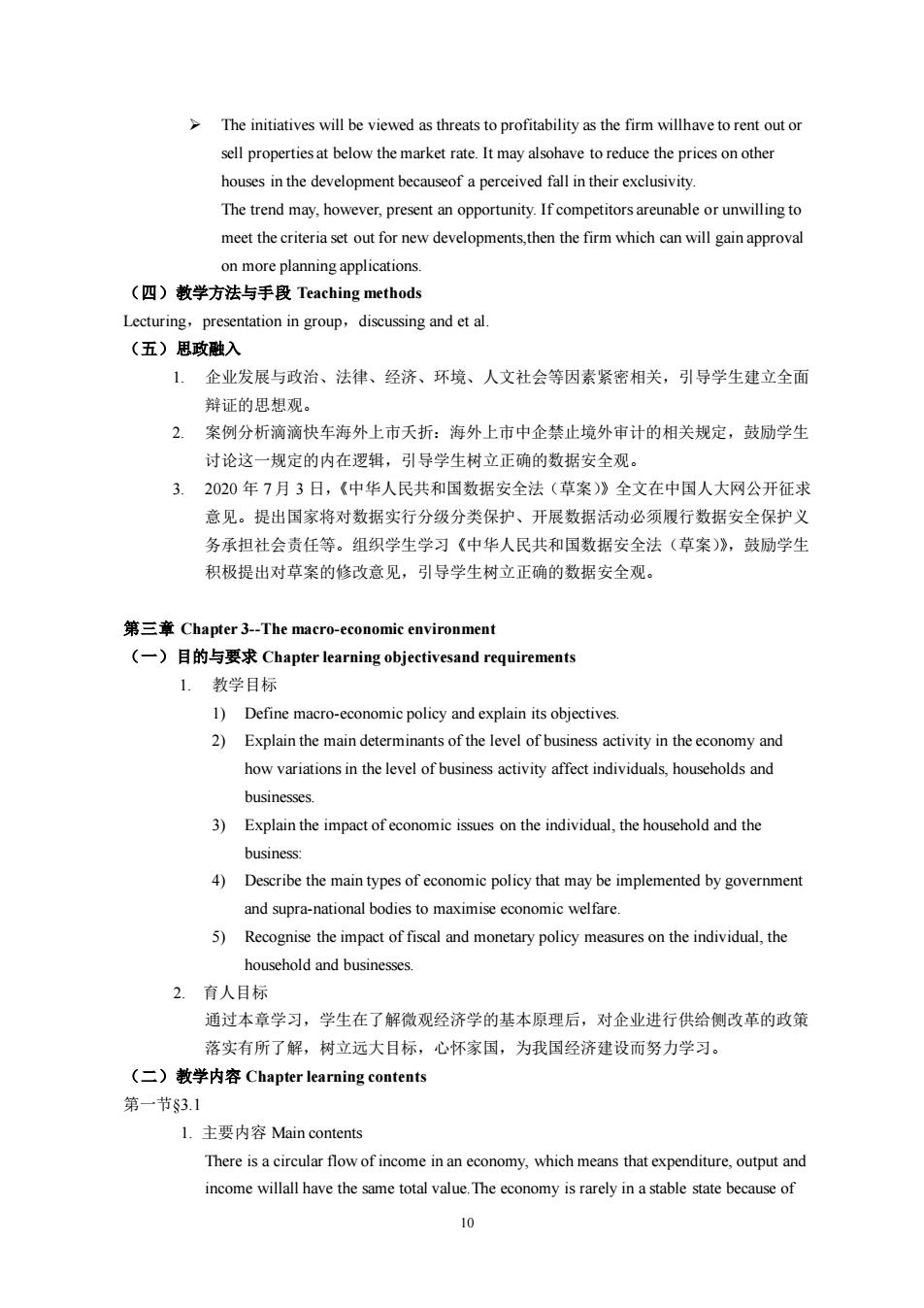
>The initiatives will be viewed as threats to profitability as the firm willhave to rent out or sell propertiesat below the market rate.It may alsohave to reduce the pricesonothe houses in the development becauseof a perceived fall in their exclusivity. The trend may,however,present an opportunity.If competitors areunable or unwilling to meet the criteria setou for new developments,then the firm which can will gain approval on more planning applications. (四)教学方法与手段Teaching methods Lecturing,presentation in group,discussing and et al. (五)思政融入 1,企业发展与政治、法律、经济、环境、人文社会等因素紧密相关,引导学生建立全面 辩证的思想观。 2.案例分析滴滴快车海外上市天折:海外上市中企禁止境外审计的相关规定,鼓励学生 讨论这一规定的内在逻辑,引导学生树立正确的数据安全观。 3.2020年7月3日,《中华人民共和国数据安全法(草案)》全文在中国人大网公开征求 意见。提出国家将对数据实行分级分类保护、开展数据活动必须履行数据安全保护义 务承担社会责任等。组织学生学习《中华人民共和国数据安全法(草案)》,鼓励学生 积极提出对草案的修改意见,引导学生树立正确的数据安全观。 第三章Chapter3-The macro-economic environmen (一)目的与要求Chapter learning objectivesand requirements 教学目标 1)Define macro-economic policy and explain its objectives 2)Explain the main determinants of the level of business activity in the economy and how variations in the level of business activity affect individuals.households and businesses 3)Explain the impact of economic issues on the individual the household and the business 4)Describe the main types of economic poliey that may be implemented by government and supra-national bodies to maximise economic welfare. 5)Recognise the impact of fiscal and monetary policy measures on the individual,the household and businesses. 2.育人目标 通过本章学习,学生在了解微观经济学的基本原理后,对企业进行供给侧改革的政策 落实有所了解,树立远大目标,心怀家国,为我国经济建设而努力学习。 (二)教学内容Chapter learning contents 第一节3.1 1主要内容Main contents There is a circular flow of income inan,which means that expenditure.output and income willall have the same total value.The economy is rarely in a stable state because of 10
10 ➢ The initiatives will be viewed as threats to profitability as the firm willhave to rent out or sell properties at below the market rate. It may alsohave to reduce the prices on other houses in the development becauseof a perceived fall in their exclusivity. The trend may, however, present an opportunity. If competitors areunable or unwilling to meet the criteria set out for new developments,then the firm which can will gain approval on more planning applications. (四)教学方法与手段 Teaching methods Lecturing,presentation in group,discussing and et al. (五)思政融入 1. 企业发展与政治、法律、经济、环境、人文社会等因素紧密相关,引导学生建立全面 辩证的思想观。 2. 案例分析滴滴快车海外上市夭折:海外上市中企禁止境外审计的相关规定,鼓励学生 讨论这一规定的内在逻辑,引导学生树立正确的数据安全观。 3. 2020 年 7 月 3 日,《中华人民共和国数据安全法(草案)》全文在中国人大网公开征求 意见。提出国家将对数据实行分级分类保护、开展数据活动必须履行数据安全保护义 务承担社会责任等。组织学生学习《中华人民共和国数据安全法(草案)》,鼓励学生 积极提出对草案的修改意见,引导学生树立正确的数据安全观。 第三章 Chapter 3--The macro-economic environment (一)目的与要求 Chapter learning objectivesand requirements 1. 教学目标 1) Define macro-economic policy and explain its objectives. 2) Explain the main determinants of the level of business activity in the economy and how variations in the level of business activity affect individuals, households and businesses. 3) Explain the impact of economic issues on the individual, the household and the business: 4) Describe the main types of economic policy that may be implemented by government and supra-national bodies to maximise economic welfare. 5) Recognise the impact of fiscal and monetary policy measures on the individual, the household and businesses. 2. 育人目标 通过本章学习,学生在了解微观经济学的基本原理后,对企业进行供给侧改革的政策 落实有所了解,树立远大目标,心怀家国,为我国经济建设而努力学习。 (二)教学内容 Chapter learning contents 第一节§3.1 1. 主要内容 Main contents There is a circular flow of income in an economy, which means that expenditure, output and income willall have the same total value.The economy is rarely in a stable state because of